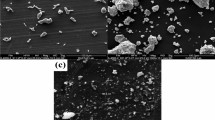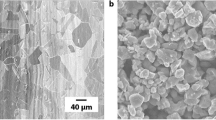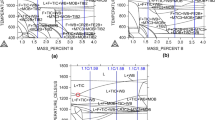New Cu–Mo composite materials were produced by physical vapor deposition (PVD) using an L5 electron-beam unit. They were proposed as an alternative to silver-containing materials for the manufacture of electrical contacts. The electrical (resistivity), mechanical (hardness, shear strength), and chemical (oxidation resistance in long-term operation at high currents and temperatures, welding resistance of contact systems at peak loads) properties of the PVD Cu–Mo composites were studied against the properties of serial electrical contact materials manufactured from AgC5 and Ag–CdO pseudoalloys. The developed materials were found to be competitive with silver-based composites in terms of output resistivity and welding resistance of contact systems at currents up to 3000 A, exceeding the rated values by more than 10 times. The resistivity increased by two to three times, but no signs of seizure (welding) were found on any contact. The brazed joint with a contact copper support for the Cu–Mo alloys showed more than two times greater strength and four times greater hardness than that for the AgC5 alloys. At the same time, the developed copper-based alloys were inferior to the silver-based alloys in oxidation resistance, in turn leading to greater resistivity and heating of the contacts. The corrosion resistance of the Cu–Mo alloys strongly depends on the presence of droplet inclusions (with corrosion processes being intensified around them), operating environment, and operating temperature of the contacts. In operating conditions with minimal oxidation processes (low humidity, room temperature), the use of copper-based contacts is much more expedient because they are less costly compared to silver-based contacts.







Similar content being viewed by others
References
Composite Material for Electrical Contacts and Method for Its Production [in Ukrainian], Ukrainian Patent 34875, IPC6 H01H1/00, C23C14/18,14/28,28/02, C22C9/00, B32B15/02, No. 99074050; appl. July 14, 1999; publ. December 16, 2002; Bulletin No. 12, p. 12.
Method for Producing Multilayer Heat-Resistant Materials [in Russian], Russian Federation Patent 2271404: IPC C23C 14/24, No. 2004112867/02; appl. April 27, 2004; publ. March 10, 2006; Bulletin No. 7, p. 18.
N.I. Grechanyuk, P.P. Kucherenko, and I.N. Grechanyuk, “New electron beam equipment and technologies of producing advanced materials and coatings,” Paton Welding J., No. 5, 25–27 (2007).
I.N. Frantsevich, “Electrical contacts produced by powder metallurgy methods,” Powder Metall. Met. Ceram., 19, No. 8, 545–554 (1980).
G.G. Gnesin (ed.), Sintered Materials for Electrical and Electronic Engineering: Handbook [in Russian], Metallurgiya, Moscow (1981), p. 343.
N.I. Grechanyuk, R.V. Minakova, and G.E. Kopylova, “Current state and prospects of high-speed electronbeam evaporation and subsequent vacuum condensation of metals and nonmetals to produce electric contacts and electrodes,” Powder Metall. Met. Ceram., 52, No. 3–4, 228–236 (2013).
N.I. Grechanyuk, V.G. Grechanyuk, E.V. Khomenko, I.N. Grechanyuk, and V.G. Zatovsky, “Modern composite materials for switching and welding equipment. Information 2. Application of high-rate vacuum evaporation methods for manufacturing electric contacts and electrodes,” Paton Welding J., No. 2, 34–39 (2016).
N.I. Grechanyuk and V.G. Grechanyuk, “Precipitation-strengthened and microlayered bulk copper- and molybdenum-based nanocrystalline materials produced by high-speed electron-beam evaporation–condensation in vacuum: structure and phase composition,” Powder Metall. Met. Ceram., 56, No. 11–12, 633–646 (2018).
N.I. Grechanyuk and V.G. Grechanyuk, “Mechanical properties of particulate and layered copper- and molybdenum-based composites,” Sovr. Elektrometall., No. 2, 43–49 (2019).
E.V. Khomenko, N.I. Grechanyuk, and V.G. Zatovsky, “Modern composite materials for switching and welding equipment. Information 1. Powdered composite materials,” Paton Welding J., No. 10, 36–42 (2015).
TU U 201134110.001-98, Precipitation-Hardened Materials for Electrical Contacts [in Russian], Technical Specifications, in effect since June 2 (1998), unlimited validity.
TU U 31.2-20113410-003-2002, Electrical Contacts Produced from Precipitation-Hardened Materials (MDK), Technical Specifications.
L.L. Grzymalskii and I. I. Ilievskii, Soldering Technique and Equipment [in Russian], Mashinostroenie, Moscow (1979), p. 240.
N.Kh. Abrikosov, Binary Multicomponent Copper-Based Systems: Handbook [in Russian], Nauka, Moscow (1979), p. 248.
T. Machej and I. Ziolkowski, “Subsolidus phase diagram of Cu2O–CuO–MoO3 system,” J. Solid State Chem., 31, 135–143 (1980).
T. Machej and I. Ziolkowski, “Phase relations in the cupric molybdates–cuprous molybdates system,” J. Solid State Chem., 31, 145–151 (1980).
R.V. Minakova, A.P. Kresanova, and N.I. Grechanyuk, “Composite materials for contacts and electrodes. Molybdenum-based materials,” Elektr. Cont. Elektrod., No. 3, 95–105 (1996).
G.V. Samsonov, Physicochemical Properties of Oxides [in Russian], Metallurgiya, Moscow (1978), p. 470.
Author information
Authors and Affiliations
Corresponding author
Additional information
Translated from Poroshkova Metallurgiya, Vol. 60, Nos. 3–4 (538), pp. 69–78, 2021.
Rights and permissions
About this article
Cite this article
Grechanyuk, N.I., Konoval, V.P., Grechanyuk, V.G. et al. Properties of Cu–Mo Materials Produced by Physical Vapor Deposition for Electrical Contacts. Powder Metall Met Ceram 60, 183–190 (2021). https://doi.org/10.1007/s11106-021-00226-0
Received:
Published:
Issue Date:
DOI: https://doi.org/10.1007/s11106-021-00226-0




